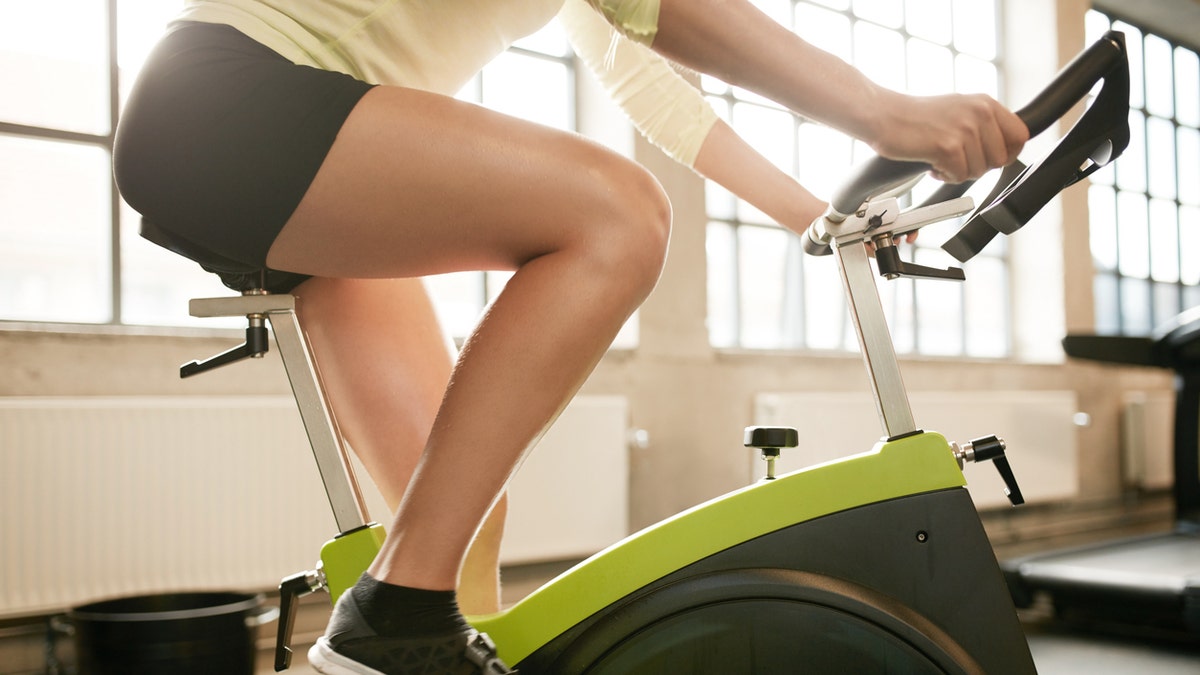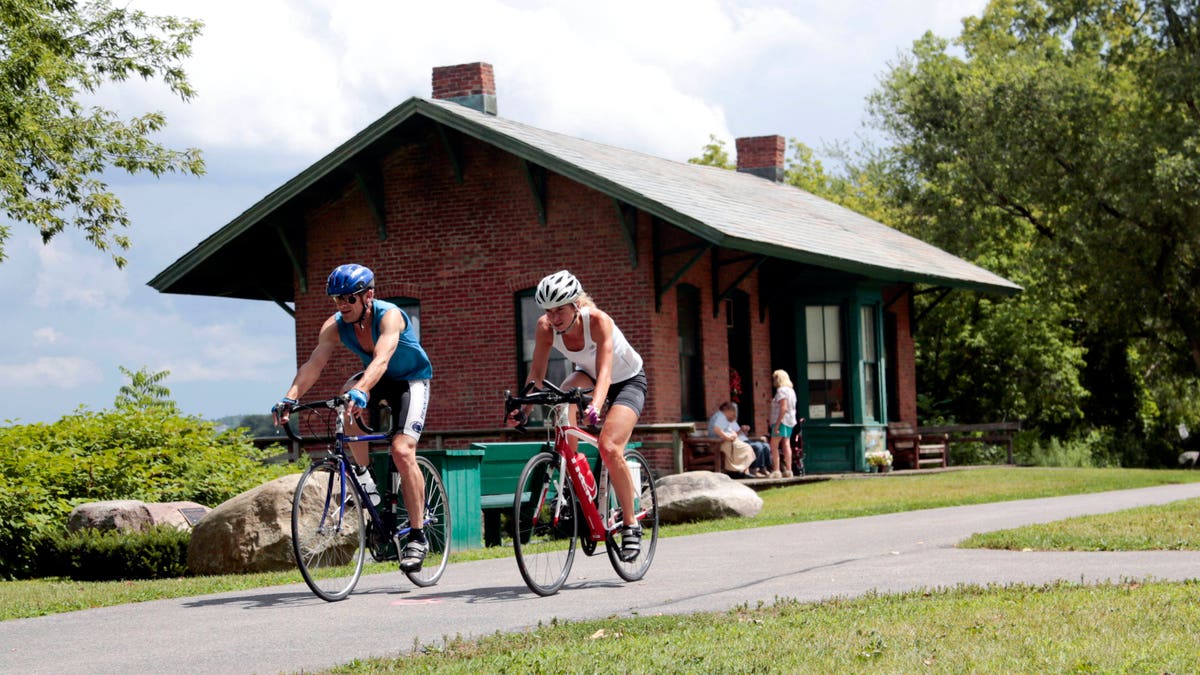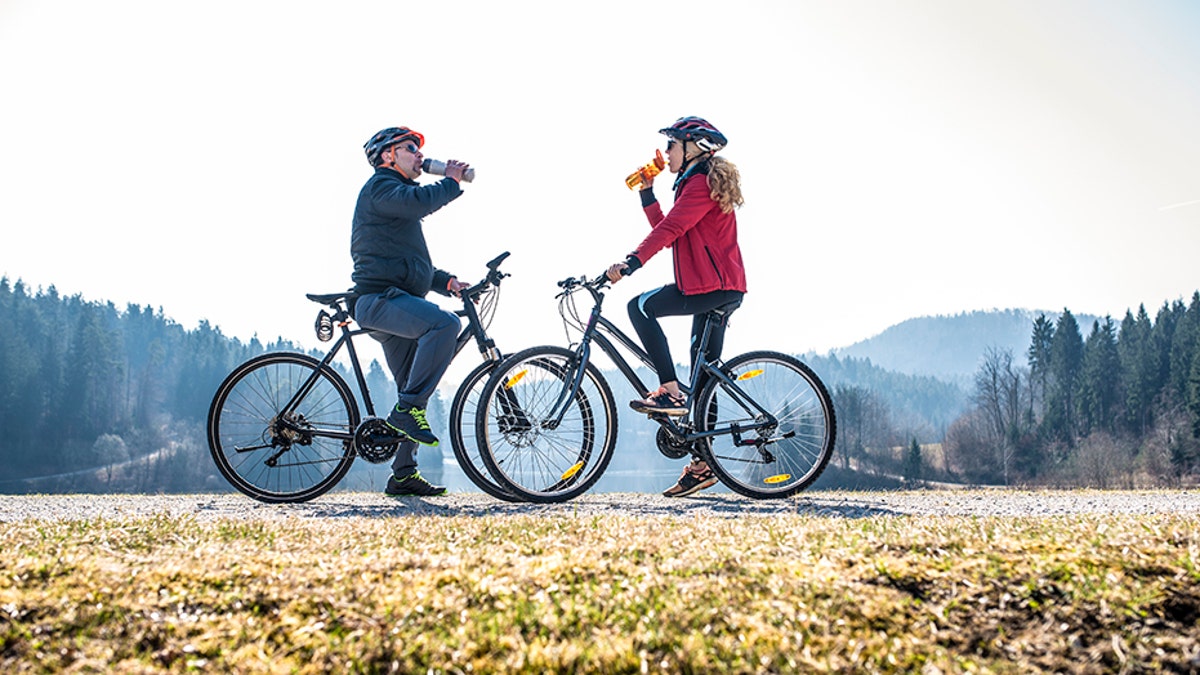Fox News Flash top headlines for January 26
Fox News Flash top headlines are here. Check out what's clicking on Foxnews.com.
When the COVID-19 pandemic first hit, fitness folks hopped onto stationary bikes at home while gyms were closed.
As virtual bike workouts increased, a recent media report stated how female cyclists participating in spin classes have been experiencing urinary incontinence possibly linked to their cycling routine.
Health experts told Fox News that pressure from the bicycle seat on the perineum (the genital area) may contribute to problems with urinary incontinence, sexual arousal, and trigger genital pain and numbness in some female and male cyclists.
Dr Philippa Kaye wrote about the possible link between spin classes and women’s incontinence in a recent media report for the outlet the Daily Mail.

Cropped shot of fitness woman working out on exercise bike at the gym. Female exercising on bicycle in health club, focus on legs. (iStock)
"A study of more than 300 female triathletes, who cycle a lot as part of their sport, reported that one in three suffered incontinence and pelvic pain. Experts have also found female cyclists can suffer decreased vaginal and labial sensitivity, and a higher rate of urinary tract infections." Kaye said in the article.
Physical therapists who treat pelvic floor issues, said complaints of pelvic pain can be common among cyclists because the sport involves pressure on the pelvic floor area. Some cyclists may complain of pain, tingling, numbness, or urinary incontinence, health experts told Fox News. These symptoms are found commonly in women but can also occur in men, health experts told Fox News.
One study that looked at the correlation between female cyclists and sexual dysfunction found that nearly 54% of the female cyclists had female sexual dysfunction (FSD), 58% complained of genital numbness, and 69% reported pain in their genital region. According to the study, frequency and duration of cycling were not associated with FSD. However, frequency of numbness was correlated with decreased arousal, orgasm, and satisfaction during intercourse, whereas the frequency of pain significantly reduced arousal, orgasm, and genital lubrication.
INCREASED DAILY EXERCISE FOR 10 MINUTES COULD PREVENT MORE THAN 100K DEATHS A YEAR: STUDY
A study looking at men who participate in cycling found a slight correlation between the years of cycling and the presence of lower urinary tract symptoms, independently of the man's age. The researchers said in the study that high-intensity cycling might have a negative impact on pelvic floor function in some men. The study’s authors did however note that further research is needed to analyze the impact of cycling on urogenital problems in this population.
Lauren Tadros, PT, DPT, is a pelvic floor physical therapist at Thrive Integrated Physical Therapy in New York City and told Fox News that she sees urological issues in male cyclists from too much cycling. In the cases of men, Tadros said, "The most common complaint is tailbone pain or scrotal and penile pain from pelvic floor irritation which can then lead to pain with ejaculation, urinary hesitancy and frequency or pain with urination. "
Elizabeth D’Annunzio Shah, PT, DPT, OCS, is also a pelvic floor physical therapist at Thrive Integrated Physical Therapy in New York City and told Fox News that although urinary incontinence may seem to be common in women, "urinating while exercising is not normal".

Cyclists pass the Niskayuna Train Station as they bike on the Canalway Trail in Niskayuna, N.Y. (AP Photo/Mike Groll, File) (Copyright 2017 The Associated Press. All rights reserved.)
The pelvic floor specialist told Fox News during an interview that individuals who experience incontinence or pain, male or female, should see a health professional to rule out an underlying condition or mechanical issue that could be exacerbated by the cycling class.
Shah explained that the muscles in the pelvic region can become tight which potentially leads to urinary frequency, or they can become weak, typically after having babies or surgeries, which can lead to incontinence. These muscle imbalances combined with the postures and breathing while doing the cycling exercises can contribute to episodes of incontinence, Shah told Fox News.
"It’s less about biking but how the person is holding their breath and posture," Shah said.
The physical therapist told Fox News that sitting alone significantly "loads" the spine and pelvic region and adding motions such as lifting weights, while cycling can further the amount of stress on the pelvic floor.
Shah said it is important for cyclists to be aware of their posture and breathing during the exercise routine.
WE MAY NOT NEED 10,000 DAILY STEPS FOR LONG LIFE, STUDIES SUGGEST
Shah explained that during a fast-paced spin class, factors like bearing down while breathing or hunching forward in a poor posture puts extra pressure on the pelvic floor, which can contribute to incontinence.
"If you sit crunched down and lift weights, along with bad mechanics, you will overload the pelvic floor," Shah said.

National Bike Month is a chance to meet other bikers, be environmentally friendly, avoid commuting traffic and save money on gas. (iStock)
Pelvic floor physical therapists address an individual’s muscle imbalances and mechanical issues that may contribute to urinary incontinence and sexual dysfunction, which can potentially help the individual, perform exercises without episodes of incontinence or pain.
Health experts offered tips to alleviate strain of the pelvic floor:
- Wider saddles. Tadros told Fox News she recommends a wider seat, which can spread the pressure out over the sit bones. The PT also recommended a padded seat or padded shorts.
- Explore using seat-post shock absorbers
- One study showed seat-post shock absorbers significantly decreased perineal (genital area) pressure by up to 59%.
- Heighten your handlebars if your handlebars are too low, it can put pressure on your pelvic floor, according to experts who also recommend handlebars be at least the height of the saddle.
- Breathe! Exhaling during exertion controls intra-abdominal pressure and may help alleviate strain on the abdominal wall and pelvic floor, according to pelvic floor experts. Some physical therapists recommend practicing exhaling as you push down on the pedal while you are pedaling during your spin class. If you feel heaviness in your pelvic floor, scale back.
- Stand Up More. According to a report in the Urology Times, urologists found cyclists who stood more than 20% of the time while cycling and adjusted the handlebar to a height at least even with the saddle had reduced odds of developing genital numbness.
CLICK HERE TO GET THE FOX NEWS
Overall, urologists said that cycling should be promoted as a healthy form of exercise and more needs to be learned about the impact of cycling on urologic wellness in men and women. Health experts also add, if you are experiencing symptoms, seek medical evaluation from a pelvic floor specialist and urologist, to rule out underlying conditions and to help promote a better quality of life.

